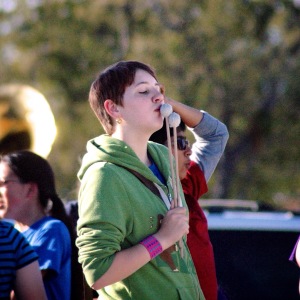A Scene, and a Revelation
 Last night, Schuyler and I were discussing the private percussion lessons she recently began taking. Her new teacher had made a video for her so she could hear how the piece they’re working on is supposed to sound, and we were watching while we practiced.
Last night, Schuyler and I were discussing the private percussion lessons she recently began taking. Her new teacher had made a video for her so she could hear how the piece they’re working on is supposed to sound, and we were watching while we practiced.
There are two things you should know about Schuyler’s percussion teacher. She was by far the most frequently and highly recommended teacher for Schuyler, and she’s deaf. This is perhaps less surprising than you might think. Percussion is a very visual musical medium, after all, and the world’s most famous and arguably most esteemed classical percussion soloist, Evelyn Glennie, is also hearing impaired. It’s fascinating to me, this unexpected inroad to musicians with disabilities, and it provides a perfect opportunity for a relevant, real-world role model with a disability for Schuyler.
It also presents some interesting communication issues. Schuyler’s percussion teacher doesn’t sign, but rather reads lips. That’s not much help with Schuyler, whose lips aren’t doing a lot of heavy lifting when she speaks. And so a big part of what Schuyler is likely to get from her private percussion lessons has little to do with drumming and everything to do with communication and information exchange.
As we watched the video and listened to her teacher count off the exercise, Schuyler turned to me with her face scrunched up.
“Daddy, she’s kind of hard to understand.”
I suppressed a smirk. “Yeah?”
“Yeah,” she said. “When she’s counting.”
I explained that to the rest of the world, and sometimes even to her mother and me, Schuyler’s own speech sounds very similar to her teacher’s. This took Schuyler by surprise.
“And when that happens, the very best thing you can do is use your device so that people can understand what you have to say. Your teacher is really smart, and so are you. Everyone deserves to be understood.”
When something finally makes sense to Schuyler, her reaction can be like something from a cartoon. Her eyes grow huge, and she gives this dramatic “Ohhhhh!” Making that connection between her teacher’s speech and her own resulted in one of those moments.
We had the first of what I suspect will be many conversations about how she and her teacher might communicate better, including the idea of letting her type on Schuyler’s iPad in moments of need. That would be a huge thing for Schuyler, who guards her iPad pretty closely, but we’ll see.
No matter what she chooses to do, however, Schuyler made an important connection. I think she now understands, for perhaps the first time, how her own voice sounds to the uninitiated world. More importantly, however, I think she sees how much that world wants to get what she has to say, and how she’s got the tools to try to make that happen.
This could be good. This could be very, very good.
Note: To support the site we make money on some products, product categories and services that we talk about on this website through affiliate relationships with the merchants in question. We get a small commission on sales of those products.That in no way affects our opinions of those products and services.


It is so fascinating to think about Schuyler understanding her voice in terms of how she hears another person. What a surprising and eye-opening moment for her! My daughter is still young (almost 4) and essentially non-verbal…but I can see that when I repeat her sounds back to her as she says them she looks at me like I have lost my mind. But if I can guess what she is trying to say correctly she claps for me. I think she “hears” herself speaking quite perfectly.